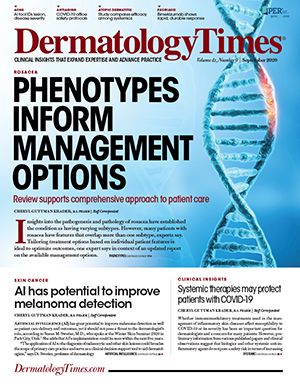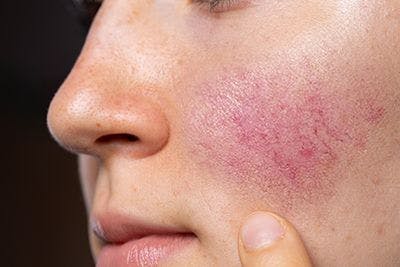- Acne
- Actinic Keratosis
- Aesthetics
- Alopecia
- Atopic Dermatitis
- Buy-and-Bill
- COVID-19
- Case-Based Roundtable
- Chronic Hand Eczema
- Chronic Spontaneous Urticaria
- Drug Watch
- Eczema
- General Dermatology
- Hidradenitis Suppurativa
- Melasma
- NP and PA
- Pediatric Dermatology
- Pigmentary Disorders
- Practice Management
- Precision Medicine and Biologics
- Prurigo Nodularis
- Psoriasis
- Psoriatic Arthritis
- Rare Disease
- Rosacea
- Skin Cancer
- Vitiligo
- Wound Care
Publication
Article
Dermatology Times
AI has potential to improve melanoma detection
Author(s):
Leveraging artificial intelligence as an assistive tool could open up opportunities for streamlining melanoma diagnosis, expanding practice scope, and enhancing patient care.
Artificial intelligence (AI) has great potential to improve melanoma detection as well as patient care delivery and outcomes, yet it should not pose a threat to the dermatologist’s role, according to Susan M. Swetter, M.D., who spoke at the Winter Skin Seminar 2020 in Park City, Utah.1 She adds that AI’s implementation could be seen within the next five years.
“The application of AI to the diagnosis of melanocytic and other skin lesions could broaden the scope of primary care practice and serve as a clinical decision support tool to aid dermatologists,” says Dr. Swetter, professor of dermatology and director, pigmented lesion & melanoma program, Stanford University Medical Center and Cancer Institute, Stanford, Calif.
“In these ways, it could bring a more standardized level of diagnostic accuracy and provide more reliable triage and patient care. By expanding access to dermatologists’ expertise, AI could democratize care and could lead to melanoma detection at an earlier, more curable stage. By reducing time spent on more mundane tasks, physicians would have more time to devote to the physician-patient relationship.”
Echoing the American Academy of Dermatology’s (AAD) position statement on the assistive role of AuI, Dr. Swetter explains that, considering the limitations of AI, there is little fear that it will replace clinicians. Convolutional neural networks (CNNs) far exceed human brain capability in terms of pattern recognition, but they cannot reproduce human decision-making skills. Computers lack the ability to “blink, think and compare” when evaluating melanocytic neoplasms or incorporate context other than the visual and dermoscopic features they’re been trained to assess.
“Furthermore, computers perform poorly in the ‘gray zone’ of diagnostic uncertainty, which is critical because diagnoses and clinical management are not always clear cut,” Dr. Swetter says. “Likewise, computers don’t work to manage the patient following diagnosis or exhibit empathy or compassion, and so they can never replace human interactions in medicine.”
What CNNs can do is to take over some of the rote aspects of classifying skin lesions. In 2017, Dr. Swetter and colleagues published a seminal paper that provided the first proof of principle for the capability of AI-based recognition of melanoma and malignant epidermal tumors.2 The researchers developed a dermatologic taxonomy of more than 2000 diseases that allowed them to create a deep learning dataset spanning the breadth of dermatology diagnoses. A CNN was trained on general skin lesion classification using nearly 130,000 clinical images. The network was built to accommodate variations in lighting, zoom, and angle inherent in photographic images.2
The algorithm, which generated as its output a malignancy probability for a given image, was ready for testing within one year. Computer “training” took only several weeks. Using clinical images of biopsy-proven lesions, CNN performance was tested for discriminating keratinocyte carcinomas vs benign seborrheic keratoses and malignant melanomas vs benign nevi.2
Testing showed that the CNN had high specificity and sensitivity. Compared to 21 board-certified dermatologists, the CNN classified the skin cancers as well as, if not better than, the human experts. When tested with dermoscopic images, the CNN outperformed the dermatologists, although, most of the participating clinicians were not experts in pigmented lesions or dermoscopy, Dr. Swetter says.
“What we showed in this paper was the ability of AI to estimate if a photographed skin lesion is likely to be skin cancer or not. That type of information might allow a clinician to decide whether the patient should undergo a biopsy or could be reassured,” she says.
Dr. Swetter points out that the CNN was not designed to introduce AI into clinical practice or into the consumer smartphone app market. She also notes other limitations: AI doesn’t work to manage a patient following its output of the probability score that a lesion is benign or malignant. However, that concept may be incorporated into various AuI algorithms in the future.
Dr. Swetter also notes the initial evaluation of the AI algorithm was done as a retrospective study and used an artificial in silico construct. Results from the next step in which the CNN performance was evaluated in a prospective clinical setting were “humbling” in terms of highlighting the impact of issues encountered in the real-world on its diagnostic accuracy. Through further testing, it became clear that the output of any deep learning algorithm is constrained by the nature of the dataset used for training.2
In this case, one of those constraints was the fact that example images in the training set were from a relatively homogenous population, which did not contain many individuals with skin of color. Future datasets will need to include lesions from people of all Fitzpatrick skin types, Dr. Swetter says.
“Otherwise we risk that the application of AI will worsen health inequities that are prevalent already,” she points out.
Dr. Swetter and her colleagues are continuing to evaluate the performance of their AI system in the clinical setting and have enlisted the collaboration of other centers for prospective, external validation testing.
“The process we are following reflects the AuI development pathway outlined in the AAD position statement, and it does not stop after clinical deployment. With collection of new data, the model can and should continue to be refined and improved,” Dr. Swetter says.
Outside of Dr. Swetter’s group, independent researchers have published papers describing CNNs for diagnosis of melanomas, nonmelanoma skin cancers, and onychomycosis using pathology, dermoscopy, and/or clinical images. Overall, the algorithms were found to perform similarly to or better than dermatologists. But, again, most were conducted in the artificial construct, and rigorous prospective clinical validation is needed before any can be incorporated into best practices.
Looking ahead, Dr. Swetter suggests that wide-scale implementation of deep learning algorithms and AI could become reality within the next five years.
“That is exciting because AI can help us move the bar towards addressing inequities in access to specialty care and improving health outcomes for all. But there is still a lot of work to be done, and we have to remember that AI will not replace the human side of medicine,” she says. “Clinicians still need to apply their judgment to decide if the AI output is correct and then decide how to apply the information for delivering the best possible patient care. Using technology to accomplish mundane tasks gives physicians more time to devote to the physician-patient relationship.”
Disclosure:
Dr. Swetter reports no relevant disclosures.
References:
1 Swetter SM.Novel Technologies to Improve Melanoma Detection and Care Focusing on Artificial Intelligence. Lecture presented at: Winter Skin Seminar 2020; January 27, 2020; Park City, UT.
2 Esteva A, Kupral B, Novoa RA, et al. Nature. 2017;542:115-118.

Newsletter
Like what you’re reading? Subscribe to Dermatology Times for weekly updates on therapies, innovations, and real-world practice tips.






























